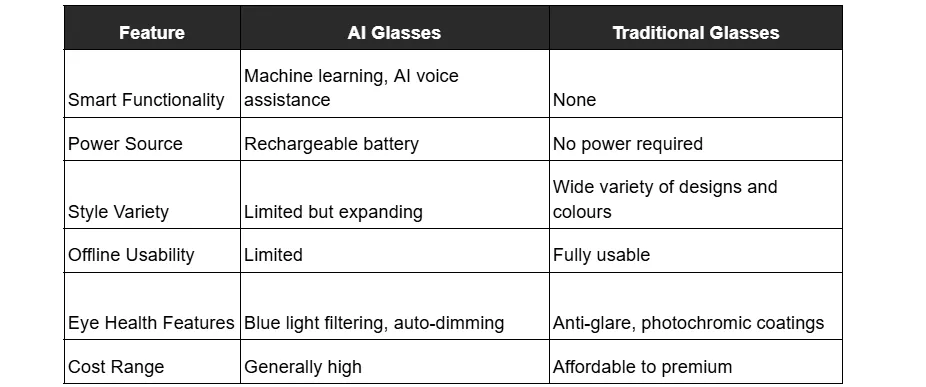- VOLUME 62: Why Are AI Glasses Gaining Popularity in 2025?
VOLUME 62: Why Are AI Glasses Gaining Popularity in 2025?
Tuesday, 1 July 2025AI glasses are fast becoming a must-have in 2025 — not just among tech enthusiasts, but also for everyday Canadians looking to simplify daily life. Unlike the traditional glasses, today’s versions offer more than just alerts — they think, translate, and learn. Thanks to built-in machine learning, these devices are helping reduce screen time and streamline tasks from work meetings to daily commutes. While not everyone is ready to make the switch, there’s no denying the shift is underway. That doesn’t mean conventional eyewear is becoming irrelevant — far from it. Whether you’re exploring your options or just curious about the direction of smart eyewear, understanding how AI glasses differ is essential.
What Sets AI Glasses Apart from Traditional Smart Glasses?
AI glasses have evolved far beyond being tech novelties. Early models of smart glasses could display messages or play music, but modern versions offer hands-free, context-aware intelligence that enhances daily routines. Here’s how today’s AI eyewear outpaces the older tech:
- Intelligent Adaptability: Rather than simply mirroring your phone, AI glasses observe your habits and respond proactively.
- Built-In AI Assistants: Voice control has levelled up — these glasses understand not just commands but context, timing, and relevance.
- Environmental Awareness: Equipped with sensors, cameras, and microphones, they interpret your surroundings to respond intuitively.
- Modern, Understated Design: No more “techy” looks — many models now resemble standard glasses, encouraging broader adoption.
- Improved Battery Life: With enhanced chip efficiency, many glasses can last the entire day without needing a charge — a big leap from their predecessors.
How AI Glasses Support Productivity and Everyday Life
For many Canadians, AI glasses have become a practical solution for reclaiming time and reducing digital clutter. From cooking at home to managing appointments on the go, these devices provide seamless support without stealing your attention. Some of the everyday perks include:
- Quick Access to Information: Instantly view directions, reminders, or texts without pulling out your phone — ideal for multitaskers.
- Real-Time Translation: Essential for international travel or multilingual workspaces, AI glasses can convert spoken and written language on the fly.
- Hands-Free Work Assistance: Professionals in fields like healthcare, logistics, and construction benefit from automated data collection and task tracking, reducing errors and improving efficiency.
- Sync with Your Digital Life: Tasks, reminders, calendars, and even shopping lists integrate across platforms, creating a smoother daily workflow.
- Enhanced Eye Comfort: Sophisticated lenses help minimise blue light exposure and adapt to varying lighting environments. Discover how digitally enhanced eyewear can benefit screen users and contribute to better eye health.
Could AI Glasses Replace Smartphones?
It’s a common question: Are AI glasses ready to replace our phones? The answer is more nuanced. While they’re gaining ground quickly, a few hurdles remain:
- Interface Challenges: Typing emails or editing content is still more practical on phones.
- Voice Control Limitations: In noisy or public settings, voice commands can be disrupted — an issue still being worked on.
- Privacy and Social Norms: The possibility of discreet recording raises ethical concerns and social discomfort.
- App Integration: Many mobile apps haven’t yet transitioned to AI glasses, which limits their current potential.
- Innovative Input Methods: As eye-tracking and gesture controls develop, we may see a shift, especially as materials and design innovations improve the practicality of smart eyewear.
Why Are Some Users Still Reluctant?
Despite advancements, AI glasses haven’t fully won over the public. For many Canadians, hesitation stems from a few key concerns:
- High Price Point: The upfront cost can be steep, especially for unfamiliar tech.
- Appearance and Social Stigma: Even with sleeker designs, the idea of wearing tech on your face still raises eyebrows.
- Privacy and Data Use: With AI glasses collecting a wealth of data, questions around data security and ownership remain top of mind.
- Prescription Compatibility: Those with complex prescriptions may still face challenges when integrating tech with their vision needs.
- Growing Confidence in Standards: On a positive note, rising mandatory safety standards for eyewear—including those adopted in Canada—are helping to boost consumer confidence both at home and around the world.
Are Regular Glasses Still Relevant?
Absolutely. While AI glasses are generating buzz, traditional eyewear remains a trusted option for millions. Their simplicity, affordability, and broad range of designs ensure they still have a firm place in the eyewear market. Here’s why standard specs still matter:
- Simple and Hassle-Free: No charging, updates, or syncing. For many tasks, that’s exactly what’s needed.
- More Budget-Friendly: Conventional glasses are easier to buy and customise without the learning curve of smart tech.
- Lens Options with Practical Benefits: Anti-reflective coatings, bifocals, and light-sensitive lenses provide tangible value without electronics.
- Everyday Functionality: From reading to driving to sun protection, traditional eyewear remains unbeatable in many scenarios.
- Tailored Fit and Expert Guidance: Choosing frames that suit your face and lifestyle often starts with advice from experienced eyewear professionals.
If you’re considering alternatives to digital wearables, take a look at the latest glasses styles designed for tech-savvy individuals. These frames combine timeless aesthetics with functional benefits. To help you see the full picture, here’s a side-by-side comparison highlighting the main differences between AI glasses and traditional eyewear:
Looking Ahead: A Place for Both
AI glasses are certainly paving the way for a smarter future in eyewear, but traditional glasses continue to serve their purpose, often better suited for simplicity, comfort, and cost-effectiveness. Whether you’re an early adopter or a classic frame fan, modern eyewear options cater to every lifestyle. Hybrid models are also gaining attention, merging subtle tech features with everyday usability.
If you’re trying to decide which type is right for you, consider exploring eyewear advice from Dresden Vision Canada. From bold innovators to minimalist wearers, there’s a frame — and a future — for everyone.

